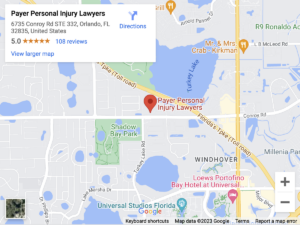
Negligence is the most common type of personal injury claim. Negligence causes of action make up the majority of auto accident claims, motorcycle accident claims, and truck accident claims, to name just a few examples. If you think you might have a negligence claim against someone, you need to understand the concept and what it means.
The Elements of a Typical Negligence Claim

To win a negligence claim, you must prove each of its elements. By most people’s count, a negligence claim has four main elements. You must prove all four of them to win your claim.
Duty of Care
The duty of care is the duty imposed upon every competent adult to conduct their affairs with enough common sense to prevent themselves from injuring other people. When driving, for example, obey traffic laws and don’t “tailgate” other drivers.
If you are a professional, such as a doctor or lawyer, you need to deal with your patients or clients in a manner that reflects the benefits of your expertise and training.
Breach of Duty
“Breach of duty” is simply the failure to meet the demands of your duty of care. There are two ways you can breach your duty of care-–by commission or omission. Commission means doing something you shouldn’t have done, while omission means failing to do something that you should have done.
The “common sense” of a jury might be enough to determine whether Dave Defendant breached their duty of care towards Vinnie Victim. By contrast, you might need an expert medical witness to determine whether Doctor Dan breached their professional duty of care towards Peter Patient.
Negligence Does Not Equal Liability
Once you establish duty and breach of duty, you have established negligence. Proving negligence, however, is not enough to prove liability and, therefore, not enough to obligate the defendant to pay you compensation. For that, you must also prove damages and causation.
Damages
“Damages” means losses that monetary compensation can remedy. Economic damages, for example, typically refer to medical care, lost earnings, and out-of-pocket expenses such as child care.
“Non-economic damages” refers to intangible losses such as pain and suffering and loss of enjoyment of life. A court might, under rare circumstances, even award you punitive damages to punish the defendant for outrageous behavior. You must prove your damages in either event.
Causation
“Causation” means a causal connection between the defendant’s negligence and your damages. Without this much, you have no claim, no matter how negligent the defendant might have been. You must prove two forms of caution-–(i) cause in fact and (ii) proximate cause.
Cause in fact
Cause in fact is present if you can honestly say, “But for the defendant’s negligence, I would not have suffered these injuries.”
Proximate cause
Proximate cause is present if you can honestly say, “Given the fact of the defendant’s negligence, a reasonable person would have foreseen the likelihood of the injuries I suffered.” In other words, proving foreseeability is the key to establishing proximate cause.
The Burden of Proof
Who has the burden of proof, the plaintiff or the defendant? Whoever has the burden of proof has the obligation of submitting evidence to prove the claim at issue. The person who asserts a claim (the plaintiff) must prove it with admissible evidence.
Once they submit their evidence, however, the defendant can try to rebut their evidence with evidence of their own. Therefore you can say that when asserting a claim, the plaintiff bears the burden of proof.
Affirmative Defenses
There is one circumstance, however, under which the defendant is the one who bears the burden of proof. That is when the defendant asserts an affirmative defense, such as expiration of the statute of limitations deadline or assumption of the risk.
“A Preponderance of the Evidence”
So what is the nature of the “burden of proof”? In other words, how much does it weigh? The party who bears the burden of proof must prove each element of their claim by a “preponderance of the evidence.”
In other words, they must convince the jury that their version of events is more likely than not to be true. This is a much easier standard to meet than the “beyond a reasonable doubt” standard that applies in criminal law.
Comparative Negligence
Comparative negligence applies when more than one party is at fault. Each party loses damages in exact proportion to their own percentage of fault—20%, for example. Any party with a percentage of fault over 50% receives nothing in damages. Other states apply different versions of this rule, but this is Florida’s stance.
Negligence Per Se
Negligence per se applies when the defendant violates a safety law or regulation. When this happens, you don’t have to prove the defendant was negligent. Violation of the law or regulation is enough to prove negligence.
Gross Negligence
“Gross negligence” is extreme negligence (for example, a DUI accident might qualify). This is important because if you can prove gross negligence, you might qualify for punitive damages.
Professional Negligence: Medical Malpractice
In a medical malpractice claim, you must establish a professional duty of care, as opposed to an ordinary duty of care, by proving the existence of a doctor-patient relationship.
An on-duty doctor owes their patients a much higher duty of care than, say, an untrained “Good Samaritan” who rendered first aid at the scene of an accident.
Contact an Orlando Personal Injury Lawyer With Your Negligence Claim
Orlando personal injury lawyers at Payer Personal Injury Lawyers handle negligence claims every day. The right lawyer could very well triple, quadruple, or even quintuple the value of your claim.
You can be sure, however, that the lawyer who is going to do this for you won’t be the one guaranteeing you that they can—no ethical lawyer will offer such a guarantee. Nevertheless, your odds are probably a lot better with a personal injury lawyer than without one. Contact us today at (407) 648-1510 to schedule a free consultation.

